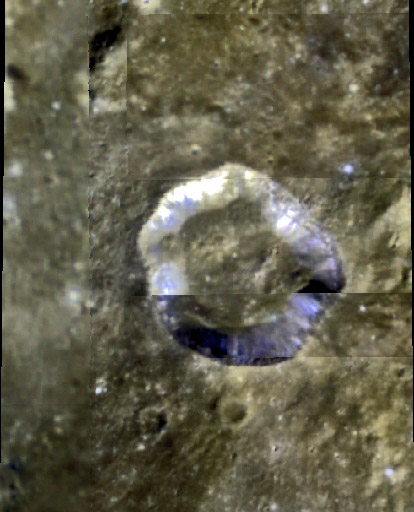Theaetetus
Contents
Theaetetus
|
Lat: 37.0°N, Long: 6.0°E, Diam: 24 km, Depth: 2.83 km, Rükl: 12 |
Images
LPOD Photo Gallery Lunar Orbiter Images Apollo Images
AS15-M-1536, Hi-Res, which is one of Apollo 15's orbital Fairchild photographs, shows Montes Caucasus "below" the curved horizon's centre, and Theaetetus immediately "above" it (west of it). A bit more "right" of Theaetetus (near the curved horizon) is Cassini (of which a little bit is visible). Note also the appearance of Calippus in Montes Caucasus! - DannyCaes Dec 18, 2007
Maps
(LAC zone 25C2) LAC map Geologic map
Description
Description: Elger
(IAU Directions) THEAETETUS.--A conspicuous ring-plain, about 16 miles in diameter, in the Palus Nebularum, N.E. of Aristillus. It is remarkable for its great depth, the floor sinking nearly 5,000 feet below the surface. Its walls, 7,000 feet high on the E., are devoid of detail. The glacis on the S.E. has a gentle slope, and extends for a great distance before it runs down to the level of the plain. Not far from the foot of the wall on the N. is a row of seven or eight bright little hills, near the western side of which originates a distinct cleft that crosses the Palus in a N.E. direction, and terminates among mountains between Cassini and Calippus. I have seen this object easily with a 4 inch achromatic.
Description: Wikipedia
Additional Information
Depth data from Kurt Fisher database
- Arthur, 1974: 2.83 km
- Westfall, 2000: 2.83 km
- Viscardy, 1985: 2.83 km
- Cherrington, 1969: 2.34 km
- Included on the ALPO list of banded craters
Transient Lunar Phenomena (TLP) near or at Theaetetus
- In 1902 the French astronomer Charbonneaux, using one of the world's largest refractors (the Meudon 33-inch, at the Paris Observatory) described how he saw a small but unmistakable white 'cloud' form close to Theaetetus, in the region of the Apennines, and various localized obscurations were reported by W.H.Pickering. Source: Patrick Moore's New Guide to the Moon (1976), page 203.- DannyCaes May 19, 2012
Nomenclature
- Theaetetus (ca. 417 B.C. – 369 B.C.) of Athens, son of Euphronius, of the Athenian deme Sunium, was a classical Greek mathematician. His principal contributions were on irrational lengths, which was included in Book X of Euclid's Elements, and proving that there are precisely five regular convex polyhedra.
- This crater was called Zylii by Michel Florent Van Langren. Now, in the world's most complete ABC of all the official and discontinued (or disallowed) names on the moon's surface, this name (Zylii) must be the very last one. - DannyCaes Jun 11, 2017
LPOD Articles
Bibliography
- A Portfolio of Lunar Drawings (Harold Hill), page 15.
